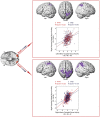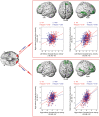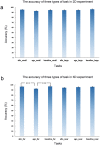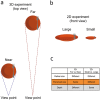Neural Correlates underlying Size Constancy in Virtual Three-Dimensional Space
- PMID: 28607416
- PMCID: PMC5468224
- DOI: 10.1038/s41598-017-03652-6
Neural Correlates underlying Size Constancy in Virtual Three-Dimensional Space
Abstract
The perceived size of an object remains relatively constant although its retinal size keeps decreasing as the object moves away along the depth dimension of the 3D space, i.e. size constancy. Neural mechanisms generating size constancy in virtual 3D space, however, remain poorly understood. By constructing a virtual 3D world in the MR scanner, we positioned the same 3D objects either near or far from the observers so that the near and far objects were perceived as having the same physical size despite their differences in retinal size. To control for the effect of differential retinal size, an additional 2D condition was introduced: a large and a small object, with matched retinal images as the near and far objects in the 3D condition, respectively, were presented on a 2D screen. Differences in retinal size activated overlapped areas in bilateral inferior occipital gyrus (IOG) in both experiments. The overlapped areas in IOG, however, showed different patterns of functional connectivity with different neural networks, depending on the perceived size of objects. In particular, IOG showed enhanced connectivity with bilateral superior parietal cortex in the 2D condition, but with inferior temporal and prefrontal cortex in the virtual 3D condition, i.e., size constancy.
Conflict of interest statement
The authors declare that they have no competing interests.
Figures





References
-
- Emmert E. Grossenverhtnisse der Nachbilder. Klin. Mbl. Augenheilk. 1881;19:443–450.
-
- Holway AH, Boring EG. Determinants of apparent visual size with distance variant. Am. J. Psychol. 1941;54:21–37. doi: 10.2307/1417790. - DOI
-
- Joynson, R. B. The problem of size and distance. Quarterly Journal of Experimental Psychologychol1 (1949).
Publication types
MeSH terms
LinkOut - more resources
Full Text Sources
Other Literature Sources

